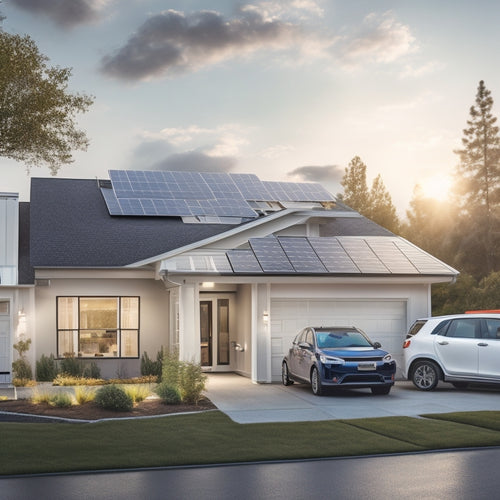
What Is the Average Cost of a Solar Installation for Your Home
Share
Your average solar installation cost ranges from $15,000 to over $30,000, with typical residential systems averaging around $20,000, depending on factors like installation size, roof orientation, equipment type, and local building codes. These costs can be affected by the type and quality of solar panels, mounting hardware, and inverters you choose, as well as the complexity of the installation process. Additionally, financing options, such as solar leasing and loans, can reduce upfront costs. To better understand how these factors impact your investment, consider exploring the details of solar installation costs and how they can benefit your home and the environment.
Key Takeaways
- The average cost of a solar installation for a home ranges from $15,000 to over $30,000, with a typical residential system averaging around $20,000.
- The cost of a solar system varies based on factors such as installation size, roof orientation, equipment type, and location.
- Financing options, including solar leasing and loans, can significantly reduce upfront costs and make solar more affordable.
- The cost of a solar installation can be offset by government incentives, such as the federal tax credit, which offers up to 26% of the installation cost.
- Understanding individual component costs, such as installation materials, labor, and permits, can help homeowners evaluate the overall investment in a solar installation.
Understanding Solar Panel Costs
When evaluating solar installation, your upfront investment hinges on the cost of solar panels, which can vary greatly depending on your energy needs and system size.
You'll need to determine the type and quality of solar panels that suit your requirements. There are three main solar panel types: monocrystalline, polycrystalline, and thin-film. Monocrystalline panels are the most efficient but also the most expensive, while thin-film panels are the least efficient but most affordable.
The installation method you choose also affects the overall cost. You can opt for a traditional roof-mounted system or a ground-mounted system, which requires more land but offers greater flexibility.
Additionally, you'll need to evaluate the installation company's labor costs, equipment, and permits. The size of your system will also impact the cost, as larger systems require more panels and materials.
Factors Affecting Installation Prices
Several factors frequently influence the overall cost of solar installation, and understanding these variables is essential for determining your total investment.
You'll want to evaluate the installation size, as larger systems generally require more equipment and labor, increasing costs. Roof orientation and angle also play a significant role, as installations on complex or multi-angled roofs can be more challenging and expensive.
Additionally, the type and quality of equipment you choose will impact your final bill. High-efficiency panels or premium inverters, for instance, may come with a higher price tag.
Your location and local building codes can also affect installation prices, as permits and inspections may be required.
Moreover, the installation company you select can influence costs, as more experienced and reputable providers may charge more for their services.
Average Cost of Solar Systems
Your solar installation's overall cost is heavily influenced by the type and size of the system you choose, with prices varying widely depending on the number of panels, inverters, and other components required.
The average cost of a solar system can range from $15,000 to over $30,000, with most homeowners paying around $20,000 for a typical residential system.
However, with solar financing options and solar leasing benefits, you can greatly reduce your upfront costs. For instance, solar leasing allows you to pay a monthly fee to use the system, eliminating the need for a large initial investment.
Financing options, on the other hand, provide you with a loan to cover the cost of the system, which you can repay over time. By exploring these options, you can make solar energy more accessible and affordable for your home.
Ultimately, the cost of your solar system will depend on your specific energy needs and the type of system you choose.
Cost Breakdown of Solar Components
The cost of a solar installation is comprised of various components, each with its own price tag. When evaluating the overall cost, it's crucial to break down the expenses into individual parts.
You'll need to factor in the cost of installation materials, including solar panels, inverters, mounting hardware, and wiring. These components account for the largest portion of the total expense. The quality and efficiency of these materials can greatly influence the overall cost.
Additionally, you'll need to take into account labor costs, which can vary depending on the complexity of the installation and the location of your home.
Permits, inspections, and interconnection fees also add to the overall expense.
Incentives and Rebate Programs
You'll be happy to know that the cost of solar installation can be greatly reduced through various incentives and rebate programs.
The federal government offers a tax credit of up to 26% of the total installation cost, which can be claimed on your tax return.
Additionally, many state and local governments offer their own incentives, such as rebates, tax credits, or property tax exemptions, which can further reduce the upfront cost of going solar.
Federal Tax Credits
Tapping into federal tax credits can markedly reduce the financial burden of going solar. As a homeowner, you're eligible for federal credits that can greatly cut down the upfront cost of your solar installation.
The Solar Investment Tax Credit (ITC) allows you to claim a tax credit of 26% of the total cost of your solar panel system. This means that if your solar installation costs $15,000, you can claim a federal tax credit of $3,900.
To qualify for the ITC, your solar panel system must be installed and generating electricity by December 31 of the tax year. You'll need to file IRS Form 5695 with your tax return to claim the credit.
The federal credits can be carried over for up to five years if you can't use the full amount in the first year. These tax benefits can be a considerable incentive for homeowners looking to switch to solar energy.
State and Local
Beyond federal tax credits, you can also investigate state and local incentives to further reduce the cost of your solar installation. These incentives vary by state and locality, so it's crucial to research what's available in your area.
Some states have implemented policies like net metering, which allows you to sell excess energy back to the grid and offset your utility bills.
-
Check your state's renewable portfolio standard (RPS), which may require utilities to generate a certain percentage of their electricity from renewable sources, creating demand for solar energy.
-
Look into local incentives, such as property tax exemptions or rebates, which can help offset the upfront cost of your solar installation.
-
Familiarize yourself with state regulations, such as interconnection policies, that can impact the installation and operation of your solar panel system.
Is Solar Power Worth the Cost
You're likely wondering if the high upfront investment in solar power is justified by the long-term benefits.
While the initial cost can be steep, you'll start seeing returns through reduced energy bills over time.
Additionally, you'll need to evaluate the environmental impact value of switching to a clean, renewable energy source.
High Upfront Investment
The sticker shock that comes with investing in solar power can be intimidating: a typical residential solar panel system costs between $15,000 and $30,000, depending on the size and quality of the equipment.
This upfront investment can be a significant barrier for you, especially if you're not sure how to finance it. However, you should know that there are ways to make solar power more affordable.
You have several options to contemplate:
-
Financing options: Many solar panel manufacturers and installation companies offer financing options that allow you to pay for your system over time. These financing plans can be customized to fit your budget and financial situation.
-
Installation loans: You can also investigate installation loans, which are specifically designed for solar panel installations. These loans often have favorable terms and can help you get the system you need without breaking the bank.
-
Government incentives: Don't forget to factor in government incentives, such as tax credits, that can help offset the cost of your solar panel system.
Long-Term Energy Savings
With solar panels installed, you can start reaping the benefits of renewable energy and saving money on your electricity bills. Long-term energy savings are a significant advantage of solar power, making it a worthwhile investment for many homeowners.
| Energy Efficiency | Solar Financing |
|---|---|
| 25-30% reduction in electricity bills | 10-15 year payback period on investment |
| 50-75% reduction in carbon footprint | 5-7 year payback period with tax credits |
| Energy independence from utility companies | 10-20% increase in property value |
| 25-50% increase in energy efficiency | 2-5% annual return on investment |
| 10-20 year warranty on solar panels | 5-10 year warranty on inverters |
As you can see, solar panels offer significant energy efficiency and long-term savings. With solar financing options available, the initial investment can be offset by the benefits of renewable energy. By switching to solar power, you'll not only reduce your carbon footprint but also increase your energy independence and property value.
Environmental Impact Value
Your decision to invest in solar power likely hinges on its environmental impact value, and rightly so. As you weigh the costs, you're probably asking yourself: is solar power worth the cost? The answer lies in its significant benefits to the environment.
Solar energy benefits are undeniable when it comes to environmental sustainability. Here are a few key advantages:
-
Reduced carbon footprint: Solar power generates clean energy, reducing your reliance on fossil fuels and lowering your carbon emissions.
-
Conservation of natural resources: By utilizing sunlight, you're using a renewable energy source that won't deplete natural resources like coal or gas.
-
Minimized air pollution: Solar energy produces no air pollutants or hazardous waste, contributing to a cleaner, healthier environment.
Frequently Asked Questions
Can I Install Solar Panels on My Own to Save Money?
You can attempt a DIY solar panel installation, but be aware that it's complex and requires obtaining installation permits, which can be time-consuming and may void warranties, so consider hiring a professional to guarantee a safe and efficient installation.
How Long Does a Typical Solar Panel Installation Take?
Like a skilled builder, you're constructing your path to renewable energy. Now, you're wondering how long it takes to complete the solar panel timeline. Typically, the installation phases unfold over 3-5 days, with permits and inspections adding a few weeks to the overall process.
Will Solar Panels Increase My Home's Property Value?
You'll be happy to know that installing solar panels can enhance your home's property value, as they're viewed as a desirable feature in a property appraisal, offering a key solar panel benefit that attracts buyers and increases resale value.
Can I Finance My Solar Panel Installation Through a Loan?
You're maneuvering a financial maze, but finding the right loan options is like opening a treasure chest; with financing benefits like low interest rates and flexible repayment terms, you can illuminate your path to solar-powered savings.
Do Solar Panels Require Regular Maintenance or Cleaning?
You'll be pleased to know that solar panels require minimal maintenance, typically needing cleaning every 6-12 months to guarantee peak performance, which can help extend their 25-30 year lifespan, giving you peace of mind and maximum energy harvesting.
Conclusion
You've got the facts, and now it's time to weigh the pros and cons. Imagine having a miniature power plant on your roof, generating enough electricity to power a small town! Okay, maybe not that much, but you get the idea. With solar power, you'll be saving a pretty penny on your energy bills and doing the planet a solid. The upfront cost may seem steep, but trust us, it's a drop in the bucket compared to the long-term benefits.
Related Posts
-

What Electric Vehicle Owners Need for Home Energy
As an electric vehicle owner, you need to optimize your home energy system to guarantee efficient, sustainable, and c...
-

Top 10 DIY Conversion Kit Reviews and Tips
You're taking the first step towards electrifying your ride, and with the right DIY conversion kit, you'll be cruisin...
-

What You Need to Know About RV Solar Maintenance
When you're out on the road, your RV's solar panel system is your lifeline. But without regular maintenance, you're l...


